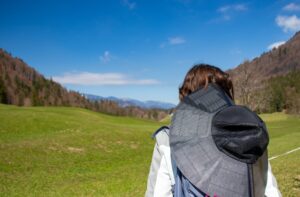Reading visual art: 140 Goose

Described in a masterful understatement as being “among the most aggressive of all poultry”, geese can be fearsome birds. They were first domesticated in Europe several millennia ago, and since then have provided meat, eggs, fat and their downy feathers to keep people fed, greased and warm. This article provides some examples of how they can be read in paintings.
Perhaps the most important myth they feature in has so far escaped the masters’ canvases. In older accounts of the Greek version of Leda and the swan, Zeus had been pursuing Nemesis, who tried shape-shifting to avoid being raped by him. She came unstuck when she changed into a goose and Zeus became a gander. Nemesis laid a single egg as a result, and that hatched into Helen, but was incubated alongside the two eggs Leda herself laid, to form the twins known as the Dioskuroi. Perhaps it’s as well no one seems to have attempted to paint that.
A goose also stars in the delightful myth of Philemon and Baucis, a pious elderly couple who were called on to provide hospitality to Jupiter and Mercury when they visited a small town in Phrygia, disguised as peasants. Despite their deep poverty, the couple served their guests with food and wine, and Philemon tried to catch the goose that guarded their cottage, to kill, cook and serve to their guests in their meal. Their goose was spared when the gods told them to leave it and abandon the town with them, as it was about to be destroyed by a flood.
David Rijckaert (III) (1612–1661), Philemon and Baucis Giving Hospitality to Jupiter and Mercury (date not known), oil on panel, 54 x 80 cm, Private collection. Wikimedia Commons.
David Rijckaert, in his Philemon and Baucis Giving Hospitality to Jupiter and Mercury, provides the most popular depiction: Mercury (left) and Jupiter (left of centre) seated at the table, with Philemon (behind table) and Baucis (centre) waiting on their every need, ensuring they eat and drink their fill. Baucis has almost caught the evasive goose, and an additional person is shown in the background preparing and serving food for the guests.
In classical times, apart from the priests and priestesses of the temples on the Capitoline Hill in Rome, their most important inhabitants were a flock of geese sacred to Juno.
Henri-Paul Motte (1846–1922), Sacred Geese of the Capitol (1889), oil on canvas, 32 x 46 cm, location not known. Wikimedia Commons.
Henri-Paul Motte’s Naturalist painting of the Sacred Geese of the Capitol from 1889 shows them being kept in ornate cages, although this loose goose seems to be arguing with one of the priestesses responsible for their care. They’re claimed to have saved the city of Rome from invasion by the Gauls in about 390 BCE, when they raised the alarm and woke sleeping Roman soldiers with their watch dogs.
By the time of William Hogarth’s moralising narrative series in the early eighteenth century, geese had acquired another connotation.
William Hogarth (1697–1764), A Harlot’s Progress: 1 Ensnared by a Procuress (engraving 1732 after painting c 1731), engraving, 30.8 x 38.1 cm, British Museum, London. Wikimedia Commons.
In the first of Hogarth’s series A Harlot’s Progress, probably painted in about 1731 before this engraved version of 1732, Moll Hackabout is shown arriving at the Bell Inn, Cheapside. Her clothing, with a fine bonnet, white dress, and flower adornments, shows her to be an innocent country girl, but she’s here being inspected by Elizabeth Needham, a notorious brothel-keeper and madame. In the doorway at the right is an equally notorious rake, Colonel Francis Charteris, and his pimp John Gourlay, who are also taking an interest in the arrival of a fresh young innocent.
In Moll’s luggage is a symbolic dead goose, suggesting her death as a result of gullibility. The address on a label attached to the dead goose reads “My lofing cosen in Tems Stret in London”, suggesting that Moll’s move to London has been arranged through intermediaries, who may well have profited from her being trafficked into the hands of Elizabeth Needham.
Mykola Bodarevskyi (1850–1921), Ukraine. A Girl with Geese (1892), oil on canvas, 76 x 103 cm, Private collection. Wikimedia Commons.
There’s a fascinating story behind Mykola Bodarevskyi’s painting of a ‘goose girl’ in Ukraine. A Girl with Geese from 1892. More generally known as the ‘Russian’ painter Nikolai Bodarevsky, he was born and initially trained in Odesa, Ukraine. The title usually given for this painting refers to Little Russia, a disparaging colonialist term for Ukraine. While Bodarevskyi worked for much of his career in Russia, he returned to live in Odesa after the October Revolution of 1917. His paintings were among those removed in Stalin’s purge of the ‘cosmopolitan’ in 1953.
Gaetano Chierici (1838-1920), A Scary State of Affairs (date not known), oil, dimensions and location not known. Wikimedia Commons.
Gaetano Chierici’s undated painting of A Scary State of Affairs calls on our experience of goose behaviour, and their size. An infant has been left with a bowl on their lap, and their room is invaded first by chickens, then by those large and aggressive geese. The child’s eyes are wide open, their mouth at full stretch in a scream, their arms raised, and their legs are trying to fend the geese away.
Children, particularly young girls, were left to tend the geese in many country districts across Europe.
Wilhelm Friedenberg (1845-1911), The Goose Girl’s Lunch (date not known), oil on canvas, 50 x 70 cm, Private collection. Wikimedia Commons.
Wilhelm Friedenberg’s undated The Goose Girl’s Lunch shows a young girl, plainly dressed as a ‘peasant’ and barefoot, sat as she enjoys a short break with her lunch. Her younger brother is fast asleep at her side, worn out by all this tending of geese.
Teodor Axentowicz (1859–1938), Goose Girl (1883), oil on canvas, 41 x 53 cm, Private collection. Wikimedia Commons.
In this loose painting by Teodor Axentowicz from 1883, his Goose Girl walks with a large flock of geese on flat and marshy land beside a river.
With the advent of specialist natural history artists in the late nineteenth century, wild geese were painted in their remote habitats, most notably by the great pioneer Bruno Liljefors.
Bruno Liljefors (1860–1939), Bean Geese Landing (1921), oil on canvas, 70 × 100 cm, location not known. Wikimedia Commons.
After the First World War, Liljefors concentrated on depicting the wildlife of Sweden’s coastal wetlands, including Bean Geese Landing above, and Geese in Wetlands below.
Bruno Liljefors (1860–1939), Geese in Wetlands (1921), oil on canvas, 60 × 100 cm, Private collection. Wikimedia Commons.
Elizabeth Nourse (1859–1938), Flock of Geese (c 1883), oil on panel, 65.8 x 142 cm, Smithsonian American Art Museum, Washington, DC. Wikimedia Commons.
For me, though, the most remarkable painting of geese must be one of the earliest surviving works of Elizabeth Nourse, her challenging Flock of Geese, from about 1883, when she could only have been twenty-four. Even with the aid of photographs this must have been tough for a relative novice to paint so convincingly.



